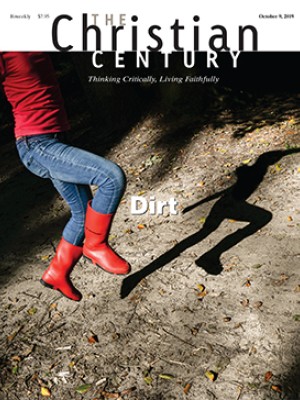I’ve always thought of Halloween as a harmless liturgical day on the secular calendar of American life. Children try out different identities with funky costumes. Doorbells light up as neighborhoods turn social. Office workers overdose on candy corn in the break room. Retailers go nuts over hefty jumps in cash flow. But when I privately toured a haunted house recently, I faced down some darker sides to Halloween. They made my stomach queasy.
“My job is to scare the hell out of anyone who walks in the door and puts down $20,” the proprietor of this “manor” told me. “I want to disturb their sleep with all the horror I can possibly think up,” he said, giddily rubbing his hands together.
Read our latest issue or browse back issues.
This operation employs as many as 60 actors on October nights. They emerge from pitch-dark corners to feign seizures, slice open lifelike bodies, and grab at unsuspecting patrons. I’m not entirely sure what possesses people to pay for gratuitous violence, but fans pour into this place by the thousands. In one room, a dog that looks as real as any black lab I’ve ever seen gets killed each night, complete with gruesome sound effects. In another room, a robed clergyman holds a knife and mutters, “I’m going to kill you.” The room with real-looking babies had me asking for the exit door. Babies hanging by their necks. Babies housed in cages. Infant body parts strewn across the blood-splattered floor.
As I moved outside to inhale the autumn air and regain my daylight bearings, I turned to speak to the owner. Not sure that an expression of gratitude was necessary for an experience with no redeeming value, I at least wanted to acknowledge the time he gave. Turning for one last look as I drove away, I decided the grotesque hellscapes of painter Hieronymous Bosch (1450–1516) seem tame in comparison with this nightmarish vision of hell I’d just witnessed. I don’t even want to think about the Halloween hell houses created by certain conservative Christians who believe they can traumatize others into salvation by offering a macabre take on the punishment that awaits the sinful.
Amusing and pleasurable seem like overly generous terms for describing the effect of these violence-filled spook houses, even if the Internet lists them as entertainment. Scaring people into shock seems more the point. Yet we live in cultural times already saturated with fright. Fearfulness has become a way in which too many view the world. Social scientists tell us that repeat experiences with shock and terror have a gradually numbing effect on our brains. They stifle our capacity for compassion and cause us to accept things we may have found previously unacceptable. Fear keeps us from being whole.
So why are some Halloween planners insistent on including frightful violence in this mostly innocent day? I don’t have a perfect answer for their motivating instincts. But their fetish for sadistic torture reminds me of the disturbing mischief caused by Mel Gibson in his blockbuster film, The Passion of the Christ. It showed Jesus relentlessly beaten to a bloody pulp through extended scenes of violence that scripture shows little interest in. I hope it’s not too much to want the next film about Christ, or next year’s Halloween, to include a few more signs of hope, joy, and life. That would be worth paying for.
A version of this article appears in the print edition under the title “Manufacturing shock.”







